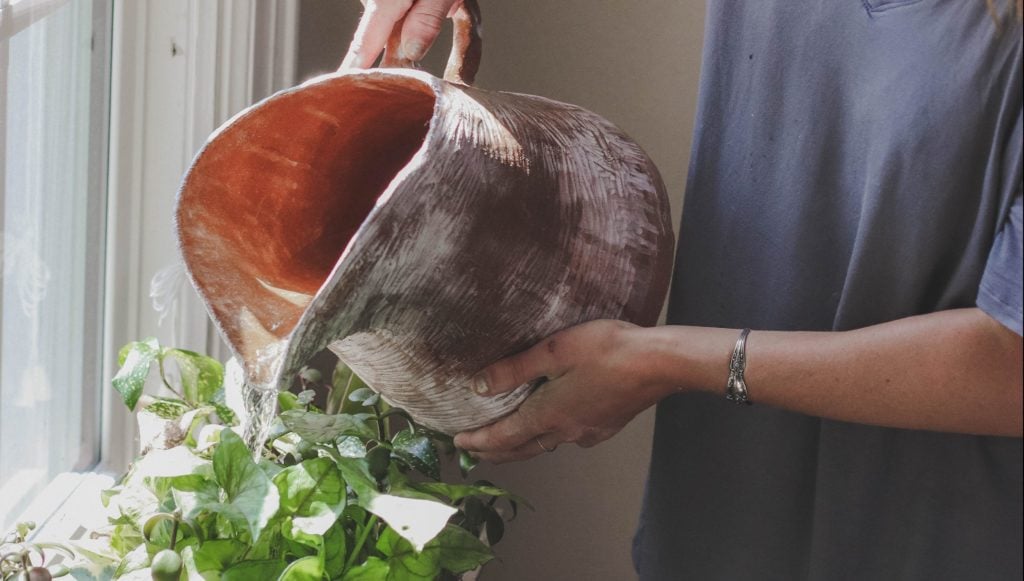Houseplants need regular applications of fertilizer for healthy growth. However, if you overdo it, you can cause great damage to the plant. Correctly recognized, you may still be able to save an over-fertilized houseplant.
If your houseplants are over-fertilized, you will recognize this by “spoon leafiness”, which means that the leaves curl upwards from the edges. In extreme cases, there are also brown leaf edges and tips. Eventually, the plants may die.

The cause is too high a salt concentration in the soil, usually caused by excessive mineral fertilizer applications. There is also a danger of overfertilization when repotting in pre-fertilized substrates and the plants are then given an additional mineral fertilizer.
Abutilon, cineraria, noble geraniums and numerous green plants are susceptible, for example.
Contents
Washing out and repotting
Remedy: When preparing the fertilizer solution, it is essential to follow the manufacturer’s instructions, as well as the recommended fertilization intervals. Fertilizing should not be done on the dry soil, because otherwise the fertilizer salts will cause plant damage.
If the symptoms of damage are recognized in time and the roots are not yet burned, it is possible to wash out the excess fertilizer salts from the soil under lukewarm running water. If it is seasonally possible, repotting in completely new soil may be advisable.
Basically, houseplants need nutrients on a regular basis. Because houseplants grow in pots, the nutrients in the soil are eventually depleted. Then the plant becomes susceptible to diseases and houseplants get yellow leaves. This also applies to (vegetable) plants on the balcony or windowsill. Fertilizing houseplants leads to better growth and a higher resistance of your plants, because they are supplied with nutrients and energy. Problems can arise from not fertilizing enough, but also from over-fertilizing.
These are signs of overfertilization
We want our plants to do well, so it happens quickly that we unintentionally overdo it with fertilizer and thus achieve the opposite. In fact, overfertilized plants can no longer absorb any nutrients at all. This can lead to the following signs:
Suddenly pests
In addition to problems with the absorption of nutrients, overfertilization leads to a weakening of the plant. The immune system of the plant is weakened. As with humans, this makes the plant vulnerable. It is easier for pests like aphids or infections like powdery mildew to attack your plant.
Saline soil
If a white deposit forms on the surface of the soil, overfertilization is often the cause. The white deposits are the first sign of a so-called salinization. It is also a clear indication that the plant is reacting to the overfertilization. It starts to release water into the soil to provide balance. Your plant dries up even though it has been watered sufficiently.
Yellow leaves
Overfertilization often causes the plant to dry up. Initial signs include brown leaf tips or yellowing leaves. If not acted upon, this will result in completely brown leaves that will eventually die completely.
Plant death
Fertilizing houseplants and thereby providing the plants with nutrients is important, but overfertilization can cause the plant to die. Often signs such as brown leaves are not interpreted correctly and as a result more watering or even more fertilizing is done. The situation worsens and often leads to the death of the plant. If you are unsure, then use our plant rescuer.
What to do when houseplants get yellow leaves due to overfertilization?
Fertilizing is not easy and even professionals make mistakes – so stay calm, even if it looks bad and your houseplants have yellow leaves – this is normal!
Rinse vigorously
If you accidentally used too much liquid fertilizer or used the fertilizer undiluted, you can flush the plant to save it. To do this, “water” the pot in the sink or shower with three times the volume of water in the pot. The goal is for the water to flush the fertilizer out of the soil. Afterwards, do not water the plant for a few days.
Repot houseplant
If you notice only after some time that you have overfertilized or observe that the plants get brown leaves despite rinsing, you should act: Now it is time to repot! This way you can exchange the salted soil for fresh soil. How to repot correctly, you can read here.









